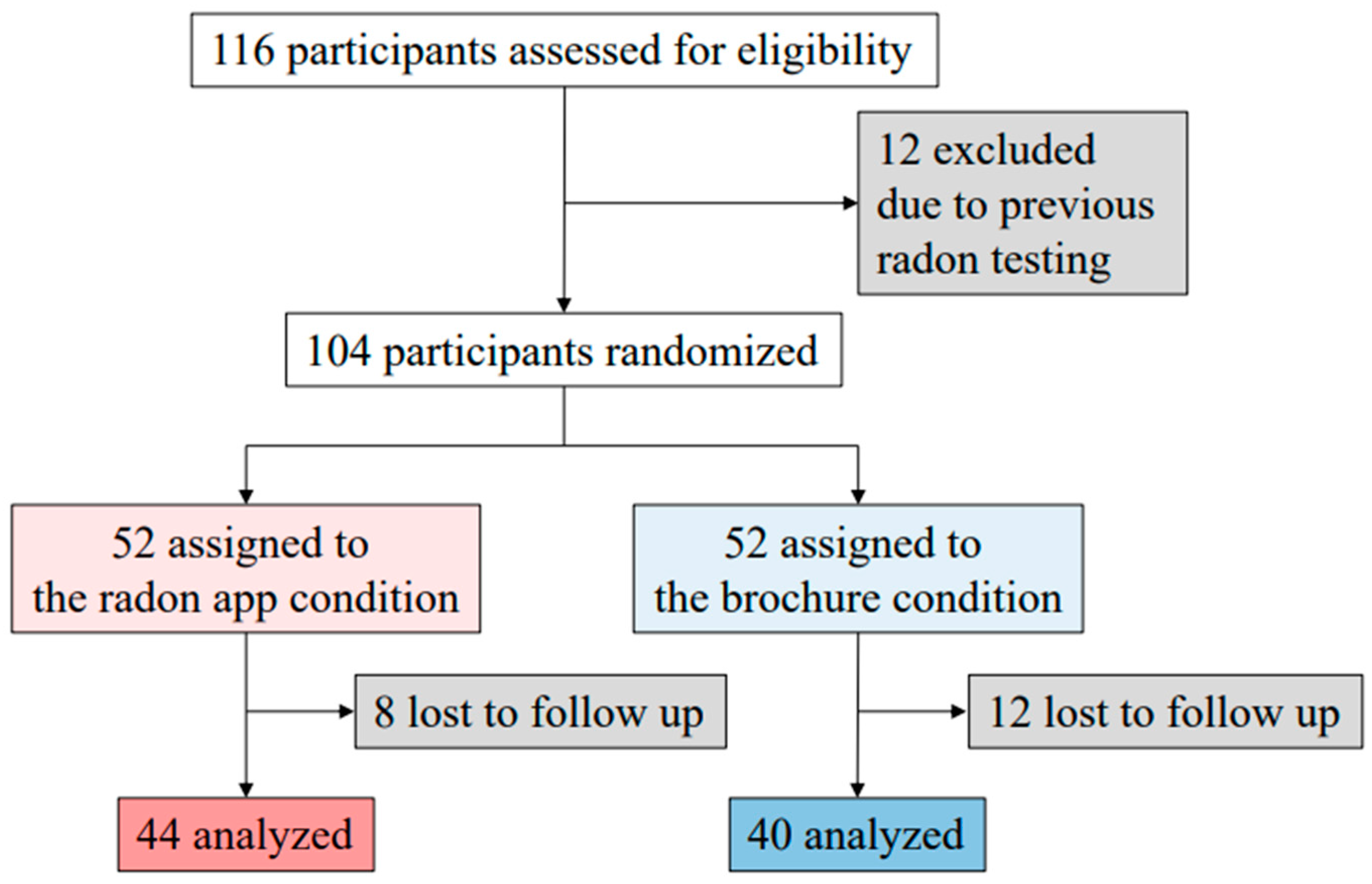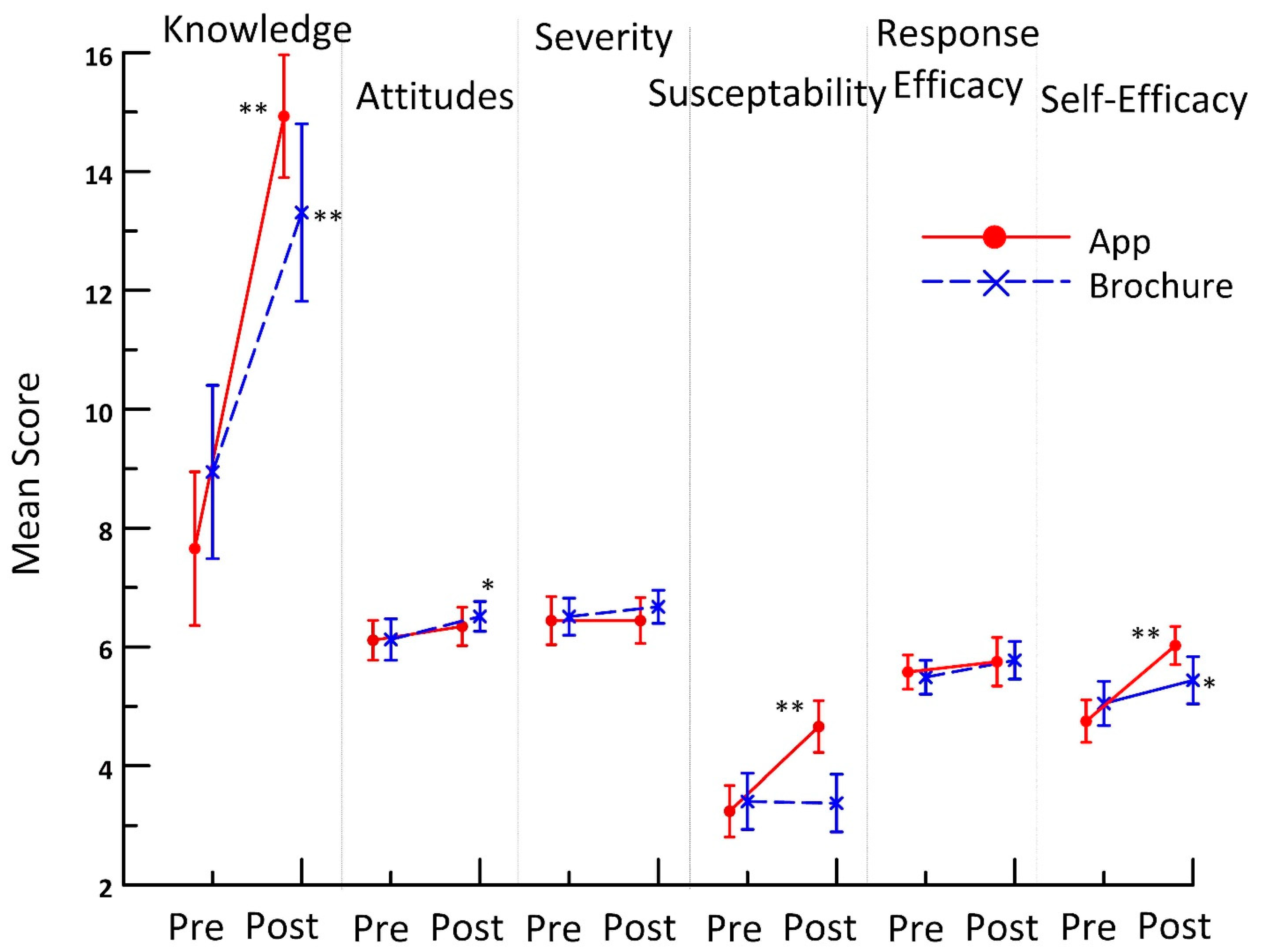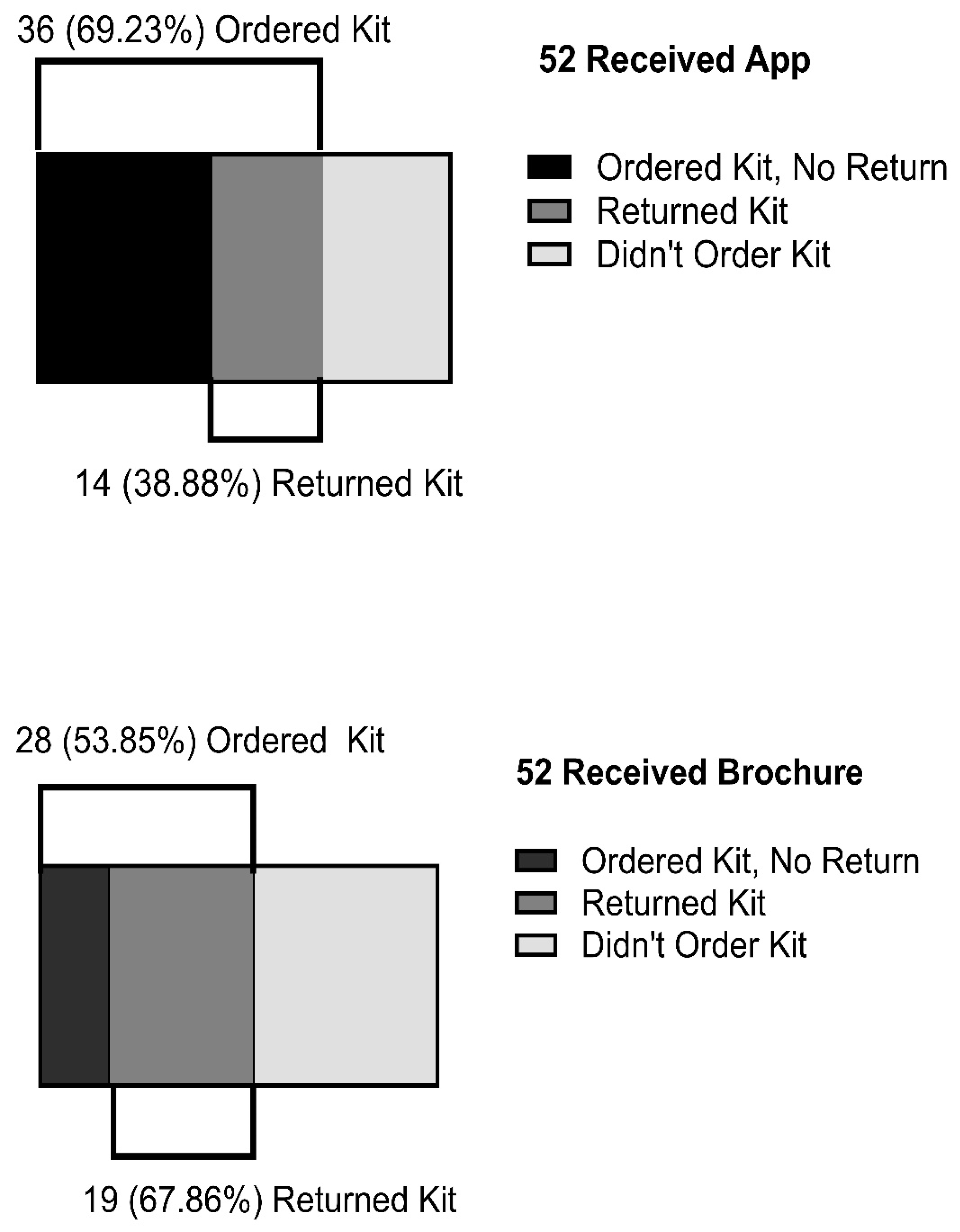Comparing Communication Methods to Increase Radon Knowledge and Home Testing: A Randomized Controlled Trial in a High-Radon City
Abstract
1. Introduction
2. Methods
3. Results
4. Discussion
5. Conclusions
Author Contributions
Funding
Institutional Review Board Statement
Data Availability Statement
Acknowledgments
Conflicts of Interest
Abbreviations
References
- EPA. Health Risk of Radon. Available online: https://www.epa.gov/radon/health-risk-radon (accessed on 1 March 2022).
- Krewski, D.; Lubin, J.H.; Zielinski, J.M.; Alavanja, M.; Catalan, V.S.; Field, R.W.; Klotz, J.B.; Letourneau, E.G.; Lynch, C.F.; Lyon, J.I.; et al. Residential Radon and Risk of Lung Cancer: A Combined Aanalysis of 7 North American Case Control Studies. Epidemiology 2005, 16, 137–145. [Google Scholar] [CrossRef] [PubMed]
- Turner, M.C.; Krewski, D.; Chen, Y.; Pope, C.A.; Gapstur, S.M.; Thun, M.J. Radon and COPD mortality in the American Cancer Society Cohort. Eur. Respir. J. 2011, 39, 1113–1119. [Google Scholar] [CrossRef]
- Mukharesh, L.; Greco, K.F.; Banzon, T.; Koutrakis, P.; Li, L.; Hauptman, M.; Phipatanakul, W.; Gaffin, J.M. Environmental radon and childhood asthma. Pediatr. Pulmonol. 2022, 57, 3165–3168. [Google Scholar] [CrossRef] [PubMed]
- Conde-Sampayo, A.; Lorenzo-González, M.; Fernández-Villar, A.; Barros-Dios, J.M.; Ruano-Ravina, A. Exposure to Residential Radon and COPD: A Systematic Review. Int. J. Chronic Obstr. Pulm. Dis. 2020, 15, 939–948. [Google Scholar] [CrossRef]
- Anthony, K.M.; Manson, J.E.; Jaiswal, S.; Natarajan, P.; Desai, P.; Hayden, K.M.; Bick, A.G.; Carty, C.L.; Collins, J.M.; Love, S.-A.; et al. Abstract P450: Radon is Associated With Clonal Hematopoiesis of Indeterminate Potential in the Women’s Health Initiative. Circulation 2020, 141, AP450. [Google Scholar] [CrossRef]
- Hamza, V.Z.; Mohankumar, M.N. Cytogenetic damage in human blood lymphocytes exposed in vitro to radon. Mutat. Res. Mol. Mech. Mutagen. 2009, 661, 1–9. [Google Scholar] [CrossRef] [PubMed]
- Kim, S.H.; Park, J.M.; Kim, H. The prevalence of stroke according to indoor radon concentration in South Koreans. Medicine 2020, 99, e18859. [Google Scholar] [CrossRef]
- U.S. Census Bureau. American Housing Survey Data. Available online: https://www.census.gov/programs-surveys/ahs/data.All.List_1739896299.html (accessed on 1 May 2022).
- Stanifer, S.R.; Rayens, M.K.; Wiggins, A.; Hahn, E.J. Social Determinants of Health, Environmental Exposures and Home Radon Testing. West. J. Nurs. Res. 2021, 44, 636–642. [Google Scholar] [CrossRef] [PubMed]
- Vogeltanz-Holm, N.; Schwartz, G.G. Radon and lung cancer: What does the public really know? J. Environ. Radioact. 2018, 192, 26–31. [Google Scholar] [CrossRef]
- Kim, S.; Chiu, T.; Klug, M.G.; Schmitz, D.; Schwartz, G.G. Interventions to promote home radon testing: A randomized clinical trial of a smartphone app vs. printed brochures. Cancer Med. 2022, 12, 2027–2032. [Google Scholar] [CrossRef]
- Tai, Z.; Dai, C. College students’ attachment to their smartphones: A subjective operant approach. BMC Psychol. 2022, 10, 1–13. [Google Scholar] [CrossRef]
- Schmitz, D.; Klug, M.G.; Schwartz, G.G. Radon Knowledge and Practices Among Family Physicians in a High Radon State. J. Am. Board Fam. Med. 2021, 34, 602–607. [Google Scholar] [CrossRef] [PubMed]
- PASS. Power Analysis and Sample Size Software. Available online: https://ncss.com/software/pass (accessed on 19 September 2022).
- Fishbein, M.; Ajzen, I. Predicting and Changing Behavior: The Reasoned Action Approach, 1st ed.; Psychology Press: New York, NY, USA, 2010; p. 538. [Google Scholar]
- Witte, K. Fear control and danger control: A test of the extended parallel process model (EPPM). Commun. Monogr. 1994, 61, 113–134. [Google Scholar] [CrossRef]
- Kim, S.; Brewster, M.S.; Schwartz, G.G. Communicating radon risk via a smartphone app: A pilot intervention study. BMC Public Health 2020, 20, 1–7. [Google Scholar] [CrossRef] [PubMed]
- Rogers, R.W. A Protection Motivation Theory of Fear Appeals and Attitude Change. J. Psychol. 1975, 91, 93–114. [Google Scholar] [CrossRef] [PubMed]
- Zahnd, W.E.; Mueller-Luckey, G.S.; Ratnapradipa, K.; Smith, T. Predictors and Spatial Variation of Radon Testing in Illinois, 2005–2012. J. Public Heal. Manag. Pract. 2018, 24, e1–e9. [Google Scholar] [CrossRef]
- Jager, M.; Demb, J.; Asghar, A.; Selby, K.; Mello, E.M.; Heskett, K.M.; Lieberman, A.J.; Geng, Z.; Bharti, B.; Singh, S.; et al. Mailed Outreach Is Superior to Usual Care Alone for Colorectal Cancer Screening in the USA: A Systematic Review and Meta-analysis. Dig. Dis. Sci. 2019, 64, 2489–2496. [Google Scholar] [CrossRef]
- Davis, M.M.; Freeman, M.; Shannon, J.; Coronado, G.D.; Stange, K.C.; Guise, J.-M.; Wheeler, S.B.; Buckley, D.I. A systematic review of clinic and community intervention to increase fecal testing for colorectal cancer in rural and low-income populations in the United States—How, what and when? BMC Cancer 2018, 18, 1–16. [Google Scholar] [CrossRef]
- Crutzen, R.; Viechtbauer, W.; Spigt, M.; Kotz, D. Differential attrition in health behaviour change trials: A systematic review and meta-analysis. Psychol. Health 2014, 30, 122–134. [Google Scholar] [CrossRef]
- United States Census Bureau. Census Bureau Releases New Educational Attainment Data. Available online: https://www.census.gov/newsroom/press-releases/2022/educational-attainment.html (accessed on 1 March 2023).
- Schwartz, G.G.; Klug, M.G. Incidence rates of chronic lymphocytic leukemia in US states are associated with residential radon levels. Futur. Oncol. 2016, 12, 165–174. [Google Scholar] [CrossRef]
- EPA. North Dakota—EPA Map of Radon Zones. Available online: https://www.epa.gov/sites/default/files/2014-08/documents/north_dakota.pdf (accessed on 1 January 2020).
- North Dakota Department of Health and Human Services. Radon Home Survey in North Dakota—1988. Available online: https://web.archive.org/web/20150419130329/http://www.ndhealth.gov/aq/iaq/radon/Home88.htm (accessed on 1 March 2022).
- Temple University. State Radon Laws. Available online: https://lawatlas.org/datasets/state-radon-laws (accessed on 1 March 2022).
- Gordon, C. Race in the heartland: Equity, Opportunity, and Public Policy in the Midwest. University of Iowa and Iowa Policy Project, 2019. Available online: https://files.epi.org/uploads/Race-in-the-Midwest-FINAL-Interactive-1.pdf (accessed on 1 March 2022).
- Apers, S.; Vandebosch, H.; Perko, T. Clearing the air: A systematic review of mass media campaigns to increase indoor radon testing and remediation. Communications 2023. [Google Scholar] [CrossRef]



| All | Radon App | Brochure | |||||
|---|---|---|---|---|---|---|---|
| N | % | N | % | N | % | ||
| Sex | Male | 29 | 27.88 | 13 | 25.00 | 16 | 30.77 |
| Female | 75 | 72.12 | 39 | 75.00 | 36 | 69.23 | |
| Age | 19–28 | 26 | 25.00 | 15 | 28.85 | 11 | 21.15 |
| 29–38 | 29 | 27.88 | 16 | 30.77 | 13 | 25.00 | |
| 39–48 | 25 | 24.04 | 9 | 17.31 | 16 | 30.77 | |
| 48+ | 24 | 23.08 | 12 | 23.08 | 12 | 23.08 | |
| Race | White | 98 | 94.23 | 51 | 98.08 | 47 | 90.38 |
| Other | 6 | 5.77 | 1 | 1.92 | 5 | 9.62 | |
| Housing | Owner | 73 | 70.19 | 34 | 65.38 | 39 | 75.00 |
| Rental | 25 | 24.04 | 15 | 28.85 | 10 | 19.23 | |
| Other | 6 | 5.77 | 3 | 5.77 | 3 | 5.77 | |
| Income | <$50,000 | 24 | 23.08 | 15 | 28.85 | 9 | 17.31 |
| $50,000–$100,000 | 30 | 28.85 | 18 | 34.62 | 12 | 23.08 | |
| >$100,000 | 44 | 42.31 | 15 | 28.85 | 29 | 55.77 | |
| Unknown | 6 | 5.77 | 4 | 7.69 | 2 | 3.85 | |
| Education | <Post-high school | 25 | 24.04 | 13 | 25.00 | 12 | 23.08 |
| College graduate | 39 | 37.5 | 21 | 40.38 | 18 | 34.62 | |
| Post-graduate | 20 | 19.23 | 10 | 19.23 | 10 | 19.23 | |
| Unknown | 20 | 19.23 | 8 | 15.38 | 12 | 23.08 | |
| Tobacco | Current | 6 | 5.77 | 2 | 3.85 | 4 | 7.69 |
| None | 98 | 94.23 | 50 | 96.15 | 48 | 92.31 | |
| E-Cigs | Current | 3 | 2.88 | 1 | 1.92 | 2 | 3.85 |
| None | 101 | 97.12 | 51 | 98.08 | 50 | 96.15 | |
| Beta | SE B | P | OR | 95% CI | ||
|---|---|---|---|---|---|---|
| LL | UL | |||||
| Ordering a kit without income (n = 104) | ||||||
| Intercept | −0.32 | 0.19 | ||||
| App | 0.66 | 0.41 | 0.109 | 1.93 | 0.86 | 4.30 |
| Ordering a kit with income (n = 98) | ||||||
| Intercept | 0.10 | 0.30 | ||||
| App | 1.24 | 0.49 | 0.011 * | 3.46 | 1.32 | 9.05 |
| Income < $50,000 | −1.61 | 0.60 | 0.007 * | 0.20 | 0.06 | 0.64 |
| Income $50,000–$100,000 | −0.79 | 0.55 | 0.149 | 0.45 | 0.15 | 1.33 |
| Testing the house without income (n = 64) | ||||||
| Intercept | 0.68 | 0.32 | ||||
| App | −1.20 | 0.53 | 0.024 * | 0.30 | 0.11 | 0.85 |
| Testing the house with income (n = 62) | ||||||
| Intercept | 1.06 | 0.42 | ||||
| App | −1.13 | 0.58 | 0.053 | 0.32 | 0.10 | 1.01 |
| Income < $50,000 | −1.95 | 0.89 | 0.028 * | 0.14 | 0.02 | 0.81 |
| Income $50,000–$100,000 | −0.29 | 0.62 | 0.637 | 0.75 | 0.22 | 2.53 |
Disclaimer/Publisher’s Note: The statements, opinions and data contained in all publications are solely those of the individual author(s) and contributor(s) and not of MDPI and/or the editor(s). MDPI and/or the editor(s) disclaim responsibility for any injury to people or property resulting from any ideas, methods, instructions or products referred to in the content. |
© 2023 by the authors. Licensee MDPI, Basel, Switzerland. This article is an open access article distributed under the terms and conditions of the Creative Commons Attribution (CC BY) license (https://creativecommons.org/licenses/by/4.0/).
Share and Cite
Kim, S.; Scheffer-Wentz, H.; Klug, M.G.; Schwartz, G.G. Comparing Communication Methods to Increase Radon Knowledge and Home Testing: A Randomized Controlled Trial in a High-Radon City. Int. J. Environ. Res. Public Health 2023, 20, 5634. https://doi.org/10.3390/ijerph20095634
Kim S, Scheffer-Wentz H, Klug MG, Schwartz GG. Comparing Communication Methods to Increase Radon Knowledge and Home Testing: A Randomized Controlled Trial in a High-Radon City. International Journal of Environmental Research and Public Health. 2023; 20(9):5634. https://doi.org/10.3390/ijerph20095634
Chicago/Turabian StyleKim, Soojung, Hannah Scheffer-Wentz, Marilyn G. Klug, and Gary G. Schwartz. 2023. "Comparing Communication Methods to Increase Radon Knowledge and Home Testing: A Randomized Controlled Trial in a High-Radon City" International Journal of Environmental Research and Public Health 20, no. 9: 5634. https://doi.org/10.3390/ijerph20095634
APA StyleKim, S., Scheffer-Wentz, H., Klug, M. G., & Schwartz, G. G. (2023). Comparing Communication Methods to Increase Radon Knowledge and Home Testing: A Randomized Controlled Trial in a High-Radon City. International Journal of Environmental Research and Public Health, 20(9), 5634. https://doi.org/10.3390/ijerph20095634





